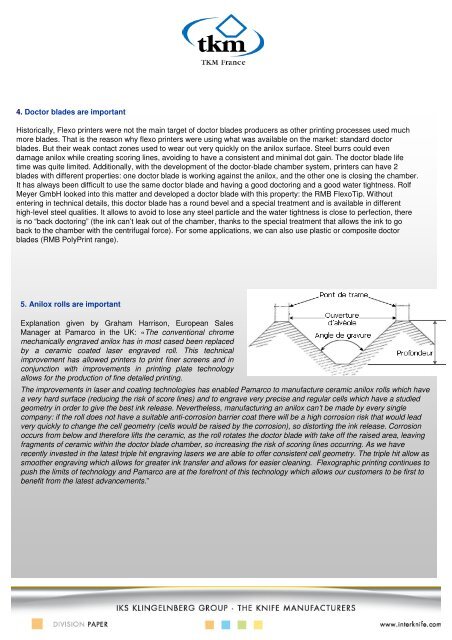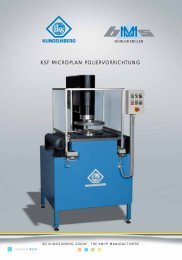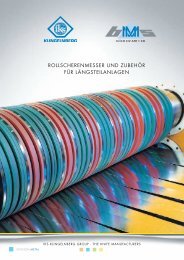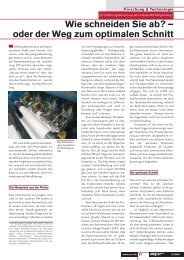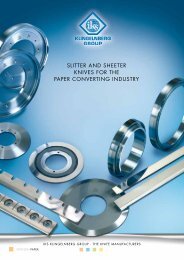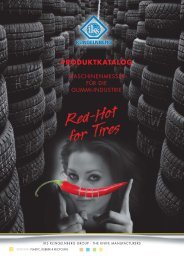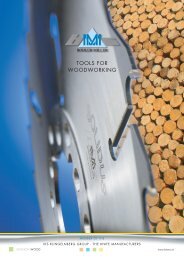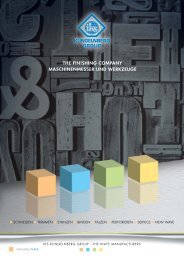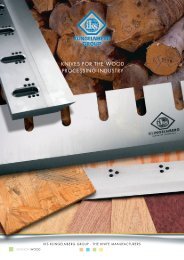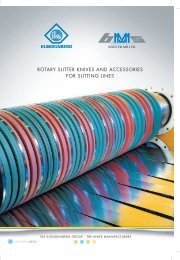Read here the second TKM France Newsletter - Rolf Meyer GmbH
Read here the second TKM France Newsletter - Rolf Meyer GmbH
Read here the second TKM France Newsletter - Rolf Meyer GmbH
You also want an ePaper? Increase the reach of your titles
YUMPU automatically turns print PDFs into web optimized ePapers that Google loves.
4. Doctor blades are important<br />
Historically, Flexo printers were not <strong>the</strong> main target of doctor blades producers as o<strong>the</strong>r printing processes used much<br />
more blades. That is <strong>the</strong> reason why flexo printers were using what was available on <strong>the</strong> market: standard doctor<br />
blades. But <strong>the</strong>ir weak contact zones used to wear out very quickly on <strong>the</strong> anilox surface. Steel burrs could even<br />
damage anilox while creating scoring lines, avoiding to have a consistent and minimal dot gain. The doctor blade life<br />
time was quite limited. Additionally, with <strong>the</strong> development of <strong>the</strong> doctor-blade chamber system, printers can have 2<br />
blades with different properties: one doctor blade is working against <strong>the</strong> anilox, and <strong>the</strong> o<strong>the</strong>r one is closing <strong>the</strong> chamber.<br />
It has always been difficult to use <strong>the</strong> same doctor blade and having a good doctoring and a good water tightness. <strong>Rolf</strong><br />
<strong>Meyer</strong> <strong>GmbH</strong> looked into this matter and developed a doctor blade with this property: <strong>the</strong> RMB FlexoTip. Without<br />
entering in technical details, this doctor blade has a round bevel and a special treatment and is available in different<br />
high-level steel qualities. It allows to avoid to lose any steel particle and <strong>the</strong> water tightness is close to perfection, t<strong>here</strong><br />
is no “back doctoring” (<strong>the</strong> ink can’t leak out of <strong>the</strong> chamber, thanks to <strong>the</strong> special treatment that allows <strong>the</strong> ink to go<br />
back to <strong>the</strong> chamber with <strong>the</strong> centrifugal force). For some applications, we can also use plastic or composite doctor<br />
blades (RMB PolyPrint range).<br />
5. Anilox rolls are important<br />
Explanation given by Graham Harrison, European Sales<br />
Manager at Pamarco in <strong>the</strong> UK: «The conventional chrome<br />
mechanically engraved anilox has in most cased been replaced<br />
by a ceramic coated laser engraved roll. This technical<br />
improvement has allowed printers to print finer screens and in<br />
conjunction with improvements in printing plate technology<br />
allows for <strong>the</strong> production of fine detailed printing.<br />
The improvements in laser and coating technologies has enabled Pamarco to manufacture ceramic anilox rolls which have<br />
a very hard surface (reducing <strong>the</strong> risk of score lines) and to engrave very precise and regular cells which have a studied<br />
geometry in order to give <strong>the</strong> best ink release. Never<strong>the</strong>less, manufacturing an anilox can’t be made by every single<br />
company: if <strong>the</strong> roll does not have a suitable anti-corrosion barrier coat t<strong>here</strong> will be a high corrosion risk that would lead<br />
very quickly to change <strong>the</strong> cell geometry (cells would be raised by <strong>the</strong> corrosion), so distorting <strong>the</strong> ink release. Corrosion<br />
occurs from below and t<strong>here</strong>fore lifts <strong>the</strong> ceramic, as <strong>the</strong> roll rotates <strong>the</strong> doctor blade with take off <strong>the</strong> raised area, leaving<br />
fragments of ceramic within <strong>the</strong> doctor blade chamber, so increasing <strong>the</strong> risk of scoring lines occurring. As we have<br />
recently invested in <strong>the</strong> latest triple hit engraving lasers we are able to offer consistent cell geometry. The triple hit allow as<br />
smoo<strong>the</strong>r engraving which allows for greater ink transfer and allows for easier cleaning. Flexographic printing continues to<br />
push <strong>the</strong> limits of technology and Pamarco are at <strong>the</strong> forefront of this technology which allows our customers to be first to<br />
benefit from <strong>the</strong> latest advancements.”


